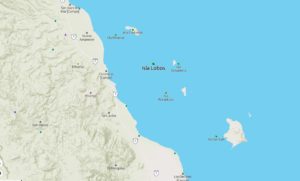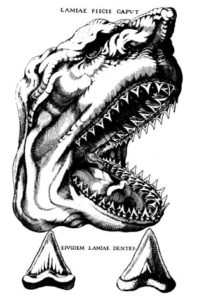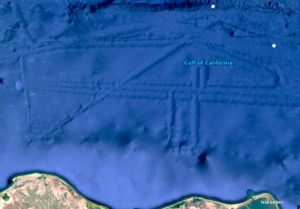Podcast: Play in new window | Download
Subscribe: Apple Podcasts | RSS
 It was a cold winter day in London. The year was 1564. English sea merchant John Hawkins had recently returned from a successful trading voyage that took him from the west African coast to the Spanish colonies of the Caribbean and South America. Hawkins made a considerable amount of money for his London investors and on that winter day in 1564 he knelt before his queen, a dour Elizabeth the First, who granted him a 700-ton ship to continue his trade exploits. After several successful commercial ventures to the New World the queen would eventually make Hawkins an admiral and then would knight him for gallantry displayed during the English defeat of the Spanish Armada in 1588. In 1567 Hawkins embarked on his third voyage which took him from west Africa to the coast of the Yucatan Peninsula and to the Spanish settlements in the modern-day Mexican state of Veracruz. While in the waters around the Yucatan, Hawkins and his crew encountered a large flesh-eating fish they had never seen before. When Hawkins asked the locals the name of this strange aquatic beast, an indigenous Maya replied “xoc,” spelled x-o-c, which was the name for the gigantic fish in the Yucatec Maya language. When Hawkins and his crew returned to England in 1569, the seafaring Englishmen added a new word to their ever-growing lexicon, “shark.” The word used to describe a creature not seen in the waters around Great Britain would be the only word in the English language with its origins in a Maya dialect. Few English speakers know of the very Mexican roots of the word “shark” or how it entered everyday English.
It was a cold winter day in London. The year was 1564. English sea merchant John Hawkins had recently returned from a successful trading voyage that took him from the west African coast to the Spanish colonies of the Caribbean and South America. Hawkins made a considerable amount of money for his London investors and on that winter day in 1564 he knelt before his queen, a dour Elizabeth the First, who granted him a 700-ton ship to continue his trade exploits. After several successful commercial ventures to the New World the queen would eventually make Hawkins an admiral and then would knight him for gallantry displayed during the English defeat of the Spanish Armada in 1588. In 1567 Hawkins embarked on his third voyage which took him from west Africa to the coast of the Yucatan Peninsula and to the Spanish settlements in the modern-day Mexican state of Veracruz. While in the waters around the Yucatan, Hawkins and his crew encountered a large flesh-eating fish they had never seen before. When Hawkins asked the locals the name of this strange aquatic beast, an indigenous Maya replied “xoc,” spelled x-o-c, which was the name for the gigantic fish in the Yucatec Maya language. When Hawkins and his crew returned to England in 1569, the seafaring Englishmen added a new word to their ever-growing lexicon, “shark.” The word used to describe a creature not seen in the waters around Great Britain would be the only word in the English language with its origins in a Maya dialect. Few English speakers know of the very Mexican roots of the word “shark” or how it entered everyday English.
Many varieties of sharks exist in both Pacific and Caribbean waters around Mexico. On the opposite end of the country from the first English encounters with sharks exists a tale of terror which has only garnered attention recently. In the waters of the Gulf of California, also known as the Sea of Cortez, between the Baja Peninsula and the state of Sonora, a gigantic dark creature is said to lurk. For generations fishermen have told tales of El Demonio Negro, or in English, “The Black Demon,” a massive, aggressive shark that overturns boats, attacks whales and swallows sea lions in a single bite. Is this just a big “fish story,” or could a previously unknown species of gigantic shark exist in the cold depths of the Sea of Cortez?
 Of the over 400 types of sharks on earth only 10 pose any danger to humans. As an apex predator, sharks tend to generate a great deal of fear even though shark attacks on people are very rare. In 2012 a 20-foot long, 2,000-pound great white shark was killed in the Sea of Cortez near the coastal city of Guaymas and was one of the largest great whites ever seen off the Mexican coast. The Black Demon shark is said to be two or three times the size of this great white and supposedly weighs between 50,000 and 100,000 pounds. Imagine a shark the size of a school bus weighing the same weight of 8 to 10 elephants with a gigantic tail larger than that of the largest whale in the ocean.
Of the over 400 types of sharks on earth only 10 pose any danger to humans. As an apex predator, sharks tend to generate a great deal of fear even though shark attacks on people are very rare. In 2012 a 20-foot long, 2,000-pound great white shark was killed in the Sea of Cortez near the coastal city of Guaymas and was one of the largest great whites ever seen off the Mexican coast. The Black Demon shark is said to be two or three times the size of this great white and supposedly weighs between 50,000 and 100,000 pounds. Imagine a shark the size of a school bus weighing the same weight of 8 to 10 elephants with a gigantic tail larger than that of the largest whale in the ocean.
Although there have been numerous stories and intergenerational tales of the Demonio Negro shark, there have been no verifiable incidents of actual attacks. No local newspapers have ever carried stories about the creature with verifiable names and dates of purported attacks. The stories say that the shark goes after medium-sized boats and then retreats to the depths of the sea, which can go down to below ten thousand feet in the Gulf of California. Half-eaten remnants of whales washed ashore are often cited as evidence of the shark’s existence. One eyewitness account often cited in the literature on this creature comes from American sport fisherman Erick Mack who was sailing off the coast of Baja in July of 2008 when he had his encounter with this gigantic fish. Mack describes it is as being around 50-feet long, dark in color and with an enormous hind flipper. The creature hit and rocked his boat, flipped up its tail and descended rapidly underwater. Mack never saw this huge fish again, but his story got nods from the locals and caught the attention of the TV series “Monster Quest” which dispatched a film crew to the Sea of Cortez to investigate. The crew set up near Lobos Island about one quarter of the way down the eastern coast of Baja. After days of investigating and filming, the “Monster Quest” show came up empty. They broadcast their findings on March 18, 2009 during their third season on an episode called “Mega Jaws.”
 Some cryptozoologists, or those who research and describe legendary creatures, claim that the gigantic black shark of Mexico may be a megalodon, a species of large prehistoric sharks that lived in the oceans from 23 million to 2.6 million years ago. The megalodon had 7-inch-long teeth and a bite force of between 24,000 to 40,000 pounds, more than three times that of a T-Rex. The average length of a megalodon was about 35 feet. The Black Demon fits the megalodon description pretty well, although some accounts by fishermen say the Mexican shark may even be bigger than the megalodon.
Some cryptozoologists, or those who research and describe legendary creatures, claim that the gigantic black shark of Mexico may be a megalodon, a species of large prehistoric sharks that lived in the oceans from 23 million to 2.6 million years ago. The megalodon had 7-inch-long teeth and a bite force of between 24,000 to 40,000 pounds, more than three times that of a T-Rex. The average length of a megalodon was about 35 feet. The Black Demon fits the megalodon description pretty well, although some accounts by fishermen say the Mexican shark may even be bigger than the megalodon.
Mexican paleontologist Roberto Díaz Sibaja in his blog, “Paleos: The History of Life on Earth,” gives an explanation as to what happened to the gigantic prehistoric fish. Translated from the Spanish:
“Megalodon became extinct before the Pleistocene began, when environmental changes caused by alterations in the circulation of marine currents cooled the world. In this new world, the megalodon food sources began to become scarce. Some went extinct and others packed their bags and they moved to the coldest waters, away from the shark that, when unable to adapt, perished. This happens when the creatures hyper-specialize in the exploitation of one or very few resources. ”
Megalodon teeth found by the HMS Challenger in the South Pacific in the 1870s have been scientifically dated to be only some 10,000 years old. While some scientists have a problem with the dating methods used, others believe that this shows that megalodons survived into modern times. Perhaps a group of these prehistoric sharks still lives in the cold depths of the Sea of Cortez  among the plentiful wildlife found in that body of water. Gigantic shark sightings have occurred in other parts of the world, too, notably off the coasts of South Africa and Australia. Although no bodies of megalodons have ever been recovered and none have ever been filmed, clues and eyewitness accounts of massive sharks lead some to believe that the megalodon never went extinct. Is Mexico’s Demonio Negro a living fossil?
among the plentiful wildlife found in that body of water. Gigantic shark sightings have occurred in other parts of the world, too, notably off the coasts of South Africa and Australia. Although no bodies of megalodons have ever been recovered and none have ever been filmed, clues and eyewitness accounts of massive sharks lead some to believe that the megalodon never went extinct. Is Mexico’s Demonio Negro a living fossil?
With no physical evidence to go with, as a cryptid, or legendary creature, the Black Demon has proved to be as elusive as bigfoot. There are many sightings of this gigantic shark, but little else to go on. Skeptics claim that the fish is simply being misidentified. The largest fish in the world, the docile, plant-eating whale shark is found in the waters of the Sea of Cortez and could be mistaken for something different. Dark shadows moving under boats could also be from various types of whales which live in the area. Untrained eyes may see a variety of things and try to explain them away by using the legend. Until a body is produced for examination or other comparable evidence presents itself, there is very little to go on.
The internet is full of fringe theories and urban legends and sometimes these theories and legends intersect. An interesting comment in the comments section of a YouTube video about the Black Demon tied the sightings of the gigantic shark with a supposed secret underwater base in the Sea of Cortez. The alleged “base” was first described by researcher Scott C. Waring after he discovered some anomalies on the ocean floor when looking at Google Maps. This 76-mile anomaly, sometimes  referred to as a “sunken city” or “alien underwater base” by fringe researchers, ironically is located 45 miles off the Baja coast near Lobos Island, the site of Eric Mack’s famous sighting and the location of the filming of the “Monster Quest” show about the Black Demon shark. A possible connection to a supposed secret underwater base brings up a whole host of new theories which, it seems, are only limited by the imagination. Whether or not this creature exists cannot be determined at this time. For now, the Black Demon plays into our most primal fear as humans and as all legends go the story will only grow and morph with time.
referred to as a “sunken city” or “alien underwater base” by fringe researchers, ironically is located 45 miles off the Baja coast near Lobos Island, the site of Eric Mack’s famous sighting and the location of the filming of the “Monster Quest” show about the Black Demon shark. A possible connection to a supposed secret underwater base brings up a whole host of new theories which, it seems, are only limited by the imagination. Whether or not this creature exists cannot be determined at this time. For now, the Black Demon plays into our most primal fear as humans and as all legends go the story will only grow and morph with time.
REFERENCES
Jones, Tom. “The Xoc, the Sharke, and the Sea Dogs: An Historical Encounter,” in Fifth Palenque Round Table, 1983, ed. Merle Greene Robertson. San Francisco: The Pre-Columbian Art Research Institute, 1983.
“Monster Quest” tv show

5 thoughts on “The Black Demon, Gigantic Shark of Mexico”
” For generations fishermen have told tales of El Demonio Negro, or in English, “The Black Demon,” a massive, aggressive shark that overturns boats, attacks whales and swallows sea lions in a single bite.”
Where can these reports/stories be found? All we ever get is someone claiming someone else (e.g. some local(s)) said x,y,z. Apart from teh fact that just because locals claim x does noit mean x is necessarily true how do we discern fact from fiction if we never get to read the original reports/stories? Any Tom, Dick or Harry can claim his boat was overturned by a sea monster or ate a whale whole. We’d be none the wiser.
” No local newspapers have ever carried stories about the creature with verifiable names and dates of purported attacks. ”
So, it is just alleged hearsay then? To how many witnesses have you actually spoken? Have you yourself tried to verify these alleged reports or are you simply copying what others claim others have allegedly claimed?
“Mack describes it is as being around 50-feet long, dark in color and with an enormous hind flipper.” Eric Mack describes speeding along in his boat on a calm day when it abruptly stopped as if it hit something in MonsterQuest. He then allegedly saw a large caudal fin, nothing more. He made no statement regarding the length of the creature whatsoever. It would be jumping to conclusions to say his boat was attacked and it makes far more sense that this was a boating accident involving a surface feeding plankton-filter like a whale shark or basking shark than some large unknown apex predator which constantly eludes us yet is allegedly seen so often by “the locals.”
“After days of investigating and filming, the “Monster Quest” show came up empty. ” Not quite true. They followed a report of an alleged sighting by a fishermen and promptly found a whale shark in the area. On the one hand, the show concluded whale sharks were the most likely explanation of the sightings, on the other the two diving specialists doing the investigation simply claimed there’s still a big mystery to be solved with nothing to show for it except hearsay. They provided a load of hoopla over nothing. With all these alleged eyewtiness reports by locals they picked two which did nothing to contribute anything meaningful to the discussion. The incidents could easily be explained by boating acidents with surface feeding plankton feeders (whale- and basking sharks)
“Some cryptozoologists, or those who research and describe legendary creatures, claim that the gigantic black shark of Mexico may be a megalodon, a species of large prehistoric sharks that lived in the oceans from 23 million to 2.6 million years ago.” Cryptozoologists (which practically anyone can become as it doesn’t require a scientific education of any sort) believe all sorts of things, often without good reasons or taking science into account. Anyone who wants to argue megs possibly still exist will have to take the scientific discussion of this animal into account instead of simply speculating.
“Megalodon teeth found by the HMS Challenger in the South Pacific in the 1870s have been scientifically dated to be only some 10,000 years old.”
Please provide a credible source for that claim. If they were scientifically dated, there’s a scientific source to back it up. Do you actually know the source this claim is based on?
Hey, that was a lot of typing. I’m not a cryptozoologist, I’m just a storyteller. 😉
*Sigh* You’re like the mayor in the first Jaws movie, where Richard Dreyfus tells him he won’t acknowledge the giant shark until it swims up and bites him in the ass. You already made up your mind and are asking for a level of proof you know is highly unlikely to be available. So, I’ll give you something by way of inference. I think it was around 1954 when a bush helicopter pilot flying over the Congo spotted a heart attack sized snake below. He fortunately had a camera, probably work related, and flew lower to take pictures of it. The snake or monster or whatever it was reared up to threaten the helicopter, so he wisely didn’t get closer. That picture was used to determine this beast to be over 100 feet long, given the surrounding trees and foliage as size comparisons. There was no photoshop at the time, no camera tricks that could do such a thing, and every debunker admitted in the end that they couldn’t debunk it. Added to that is the high credibility of the former military chopper pilot, as unlikely a liar as you’ll find on this planet. So, if that monster can exist in the Congo, this ginormous shark(s) can too in a much, much, more vast unexplored area than the Congo. Feel free to look up the giant Congo snake photo on the internet and be glad that the thing is someone else’s problem.
Great storytelling and reply!
Thanks!